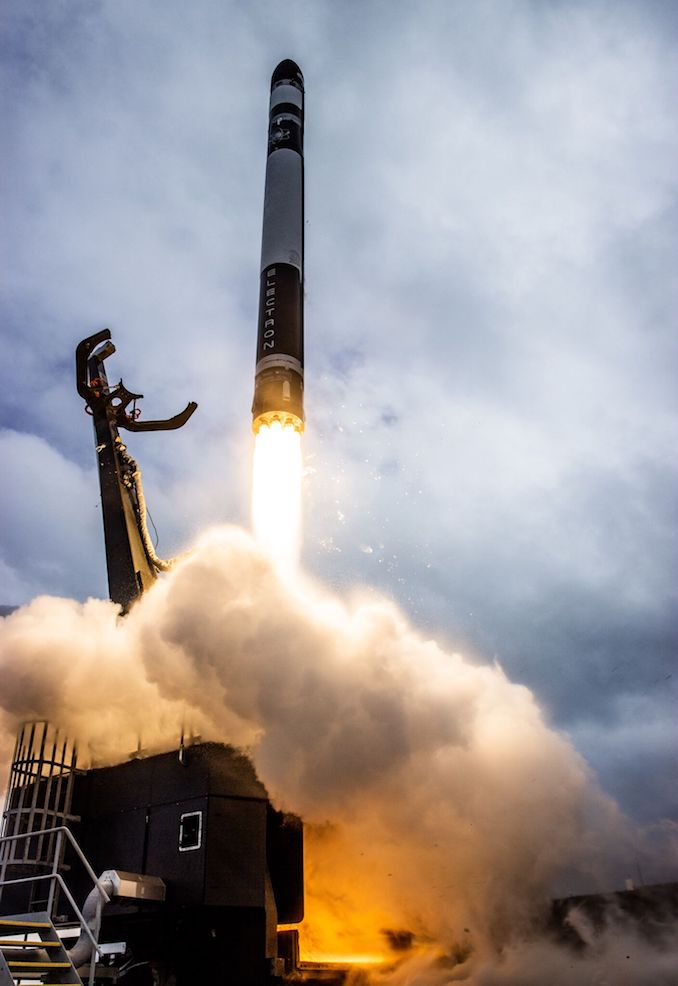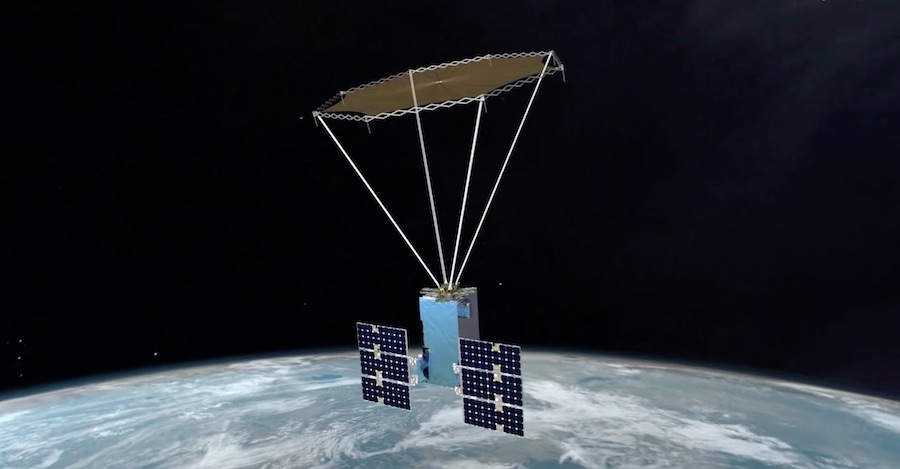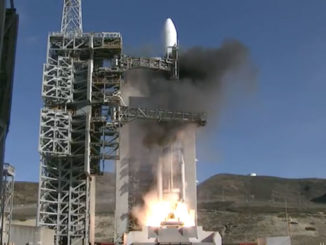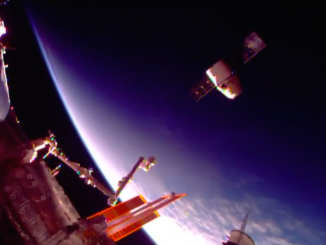
A Rocket Lab Electron rocket climbed into orbit from New Zealand Thursday (U.S. time) with an experimental payload for a U.S. military research and development agency to demonstrate the performance of a compact, deployable antenna that could expand the communications capabilities of future small satellites.
The 55-foot-tall (17-meter) rocket, powered by nine kerosene-fueled 3D-printed Rutherford main engines, fired off its launch pad on New Zealand’s North Island at 7:27 p.m. EDT (2327 GMT) after a four-day delay to allow time for crews to replace a video transmitter and wait for improved weather conditions.
The Electron rocket headed east from Rocket Lab’s commercial spaceport on Mahia Peninsula, where liftoff occurred at 12:27 p.m. local time Friday. The slender all-black launcher, sized for small satellite launches and made of lightweight carbon composite materials, soared through broken clouds and released its first stage to fall into the sea two-and-a-half minutes into the mission.
A single Rutherford engine on the Electron’s second stage ignited to accelerate into a preliminary parking orbit, then a Curie kick stage maneuvered into a nearly circular orbit with an average altitude of roughly 264 miles (425 kilometers) and an inclination of 39.5 degrees to the equator.
Rocket Lab’s webcast of the launch ended after the conclusion of the Electron’s second stage engine burn around 10 minutes after liftoff, but the company confirmed the final kick stage maneuver occurred as planned. Separation of the Defense Advanced Research Projects Agency’s R3D2 satellite was timed for approximately 53 minutes after liftoff.
Officials declared success after the R3D2 satellite’s deployment from the Curie kick stage, extending Rocket Lab’s streak of successful launches to four in a row after the inaugural Electron test flight fell short of orbit in 2017. DARPA says the Radio Frequency Risk Reduction Deployment Demonstration, or R3D2, satellite was developed in a little more than 18 months, an unusually quick pace for a space mission.
“Congratulations to our dedicated team for delivering another important and innovative asset to space – on time and on target,” said Peter Beck, founder and CEO of Rocket Lab. “The unique requirements of this mission made Electron the perfect launch vehicle to lift R3D2 as a dedicated payload to a highly precise orbit.”
The U.S.-New Zealand launch provider plans to ramp up to a pace of one launch per month later this year. Rocket Lab is building a second Electron launch pad at the Mid-Atlantic Regional Spaceport at Wallops Island, Virginia, for missions beginning by the end of this year.
The 330-pound (150-kilogram) R3D2 spacecraft will demonstrate a new type of membrane reflect array antenna that can be packed into a tight volume for launch on a small rocket, then unfurl once in space.

R3D2’s antenna is made of a tissue-thin Kapton membrane, and will deploy to a diameter of nearly 7.4 feet (2.25 meters) in orbit, according to DARPA.
During a demonstration mission slated to last at least six months, engineers will monitor the dynamics of the antenna’s deployment, and evaluate its performance.
“The antenna could enable multiple missions that currently require large satellites, to include high data rate communications to disadvantaged users on the ground,” officials wrote in a mission summary posted on DARPA’s website. “A successful demonstration also will help prove out a smaller, faster-to-launch and lower cost capability, allowing the Department of Defense, as well as other users, to make the most of the new commercial market for small, inexpensive launch vehicles.”
DARPA says the R3D2 satellite cost approximately $25 million, and the agency’s commercial launch contract with Rocket Lab has a value of $6.5 million.
“The Department of Defense has prioritized rapid acquisition of small satellite and launch capabilities. By relying on commercial acquisition practices, DARPA streamlined the R3D2 mission from conception through launch services acquisition,” said Fred Kennedy, director of DARPA’s Tactical Technology Office. “This mission could help validate emerging concepts for a resilient sensor and data transport layer in low Earth orbit – a capability that does not exist today, but one which could revolutionize global communications by laying the groundwork for a space-based internet.”
Northrop Grumman is prime contractor for the R3D2 mission and assembled the satellite. Blue Canyon Technologies of Boulder, Colorado, provided the spacecraft platform, and MMA Design in Louisville, Colorado, built the antenna. Trident Systems, headquartered in Fairfax, Virginia, designed and built R3D2’s software-defined radio, DARPA said.
MMA Design’s Pantograph Deployable High-Gain Reflectarray antenna can work in a wide range of radio frequencies — from UHF to Ka-band — supporting broadband, voice, video and data relay missions.
The antenna is scheduled to unfurl to its full size around a week after launch to commence a series of tests for DARPA, including the downlink of encrypted data to U.S. government ground terminals, the agency said in response to questions from Spaceflight Now.
“What we’re doing on this mission primarily is demonstrating a new high compaction ratio deployable antenna,” said Lindsay Millard, DARPA’s R3D2 program manager. “An antenna has a lot of different uses for DoD. One example is communication. The antenna and the power you have on the satellite dictates what size of antenna you need on the ground to receive it, so the bigger the antenna you can have in space, the smaller the one can be on the ground.
“Fitting that very big antenna into a smaller satellite makes the satellite less expensive, and allows us to leverage different types of launch vehicles that maybe we wouldn’t be able to use for bigger satellites,” Millard said.
The mission is set to last up to six months, but the spacecraft is designed for an 18-month lifetime.
“It has four different carbon fiber deployment mechanisms that will go out on each corner, then it has a pantograph, which is a shape that kind of looks like an accordion, around the outside that will expand,” Millard said. “Then we will begin to see how flat the antenna is, we’ll do some assessments from the ground to see what it might be able to transmit.
“What’s really making the antenna work is the copper etchings on top of the Kapton,” Millard said. “Kapton looks a lot like cellophane you might have in an Easter basket, and so it’s a great place to hold the copper, which is what is reflecting the energy, and it’s just set into the Kapton. So when electromagnetic radiation hits the antenna, it acts like a parabola and focuses that energy.”
The R3D2 mission was Rocket Lab’s first launch for the U.S. military, and the company’s first launch of a microsatellite, after previous Electron flights carried clusters of much smaller CubeSats to space.
Email the author.
Follow Stephen Clark on Twitter: @StephenClark1.



